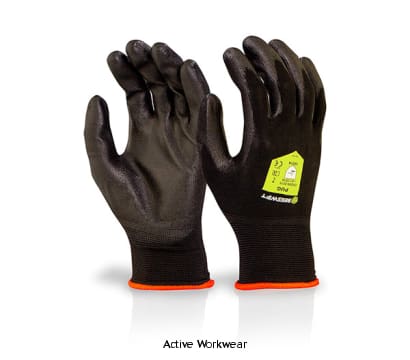Essential Guide to Electrician Safety: How Gloves Prevent Shocks and Burns
- by Mike Johnson

Essential Guide to Electrician Safety: How Gloves Prevent Shocks and Burns
Electricians are often exposed to various hazards in their line of work. From electrical shocks and burns to cuts and abrasions, these professionals need to be adequately protected to safely carry out their tasks. One of the most critical pieces of personal protective equipment (PPE) for electricians is gloves.
This comprehensive guide will delve into the importance of gloves for electricians, how they provide protection, and the best gloves for electricians available at Active Work Wear.
The Evolution of Electrician Gloves
Electrician gloves, also known as dielectric gloves, have come a long way since their early days. Initially, they were rudimentary protective tools, usually made from leather or cotton, offering minimal protection.
However, with advancements in technology and materials, today's gloves are meticulously designed to provide optimal safety, comfort, and functionality.
Contemporary gloves for electricians are made of non-conductive materials like rubber or silicone, providing insulation against electrical shocks and burns. They are also designed to be durable and flexible and exhibit high dielectric properties, meaning they can protect the wearer from even the highest voltages.
The Role of Regulations in Glove Development
Regulations set by safety and health bodies like the Health and Safety Executive (HSE) have played a significant role in the evolution of electrician gloves.
These regulations stipulate the design, in-service care, and usage of gloves. They also require that gloves are periodically tested and classified based on their voltage protection level and resistance to ozone.
Understanding Gloves Classification
Electrician gloves are classified into different classes depending on the level of voltage they can protect against:
- Class 00 - Maximum Voltage Use: 500 volts; A/C-proof Tested: 5,000 AC volts
- Class 1 - Maximum Voltage Use: 7,500 volts; A/C-proof Tested: 10,000 AC volts
- Class 2 - Maximum Voltage Use: 17,000 volts; A/C-proof Tested: 20,000 AC volts
- Class 3 - Maximum Voltage Use: 26,500 volts; A/C-proof Tested: 30,000 AC volts
- Class 4 - Maximum Voltage Use: 36,000 volts; A/C-proof Tested: 40,000 AC volts
Electrician gloves are also classified into "types" based on their ozone resistance:
- Type I - not resistant to ozone
- Type II - resistant to ozone
The Importance of Gloves for Electricians
Electrician gloves serve multiple purposes in safeguarding the hands of electricians:
- Protection from Electrical Shocks and Burns - The primary purpose of gloves for electricians is to insulate the hands from electrical shocks and burns. They provide a protective barrier against electrical currents, thereby preventing injuries.
- Protection from Cuts and Abrasions - Often, electricians' tasks involve handling sharp objects or tools. Gloves made from durable materials can protect against cuts and abrasions, enhancing safety.
- Enhanced Grip - Gloves can also enhance the grip on tools and equipment, reducing the risk of accidents caused by slipping or dropping tools.
- Compliance with Safety Regulations - Using appropriate gloves is often a requirement under health and safety regulations. Non-compliance can lead to legal implications and compromise the safety of the workers.
Selecting the Right Electrician Gloves
Choosing the right gloves for electricians involves considering several factors:
Material
The gloves' material is a critical consideration as it determines the level of protection, durability, and comfort. Gloves made from rubber or silicone offer excellent electrical insulation.
Size and Fit
Gloves should fit well to ensure comfort and functionality. A well-fitting glove enhances grip and reduces hand fatigue, thereby improving productivity.
Voltage Protection Level
The gloves' class should be chosen based on the maximum voltage that the electrician is expected to work with.
Ozone Resistance
If the work environment involves exposure to ozone, Type II gloves that are ozone-resistant should be selected.
Regulatory Compliance
The gloves should meet the requirements of safety and health regulations.
Active Work Wear: Your Trusted Provider of Electrician Gloves
At Active Work Wear, we're not just suppliers; we're partners in ensuring your safety on the job. We know that for electricians, every day brings new challenges and risks.
That's why we've curated a selection of gloves that don't just meet safety standards—they exceed them, offering you the protection you need to work with confidence.
Here's how our gloves cater specifically to the needs of electricians:
1. BEESWIFT (PUGGY) PU COATED NYLON WORK GLOVE (PACK OF 100 PRS) - PUG
These gloves are engineered for the electrician who demands durability. The PU coating isn't just for enhanced grip; it's for ensuring you can twist, turn, and manipulate even the smallest components without hesitation or slip.
EC9 BEESWIFT Affordability meets safety. These gloves are for the budget-conscious electrician who still values protection. The PU coating means you're prepared for intricate wiring tasks where precision and a steady hand are essential.
In today's digital world, an electrician's glove must be as smart as the devices they work on. These gloves not only shield you from electrical hazards but also keep you connected, allowing you to use touchscreens without removing your protection.
For the electrician facing sharp edges and rough surfaces, these gloves offer a defence that matches your resilience. The leather palm is designed to let you grip and handle the toughest materials so you can focus on the task, not the risk.
Each pair of gloves in our collection is a testament to Active Work Wear's commitment to the electrician's trade—your safety, your efficiency, and your peace of mind are at the forefront of what we do. Choose the glove that fits not just your hand but also the demands of your profession.
Gloves for electricians are an essential piece of personal protective equipment (PPE), providing crucial protection against electrical shocks and burns. At Active Work Wear, we are committed to offering the highest quality workwear to ensure the safety and well-being of professionals across various industries.
Protective Measures: FAQs on Electrician Gloves
1. Why are electrician gloves essential for safety?
Electrician gloves are crucial for preventing electrical shocks and ensuring safe handling of electrical components, making them a must-have for any electrical work.
High-quality electrician gloves are typically made from dielectric materials like rubber, often with a protective leather outer layer for added durability.
3. How do I choose the right electrician gloves size and type?
Selecting the correct size and type of electrician gloves depends on the voltage you'll be working with and the fit that ensures safety and dexterity.
4. Can electrician gloves be used in all weather conditions?
Yes, electrician gloves are designed to protect in various weather conditions, but it's crucial to ensure they are dry and undamaged before use.
5. How often should electrician gloves be replaced or tested?
Regular testing and replacing electrician gloves are vital to maintain safety standards, with many professionals recommending inspection before each use.
6. Are there specific gloves recommended for high-voltage work?
For high-voltage work, special gloves rated for higher voltages are required, which should meet the standards set by safety regulations.









